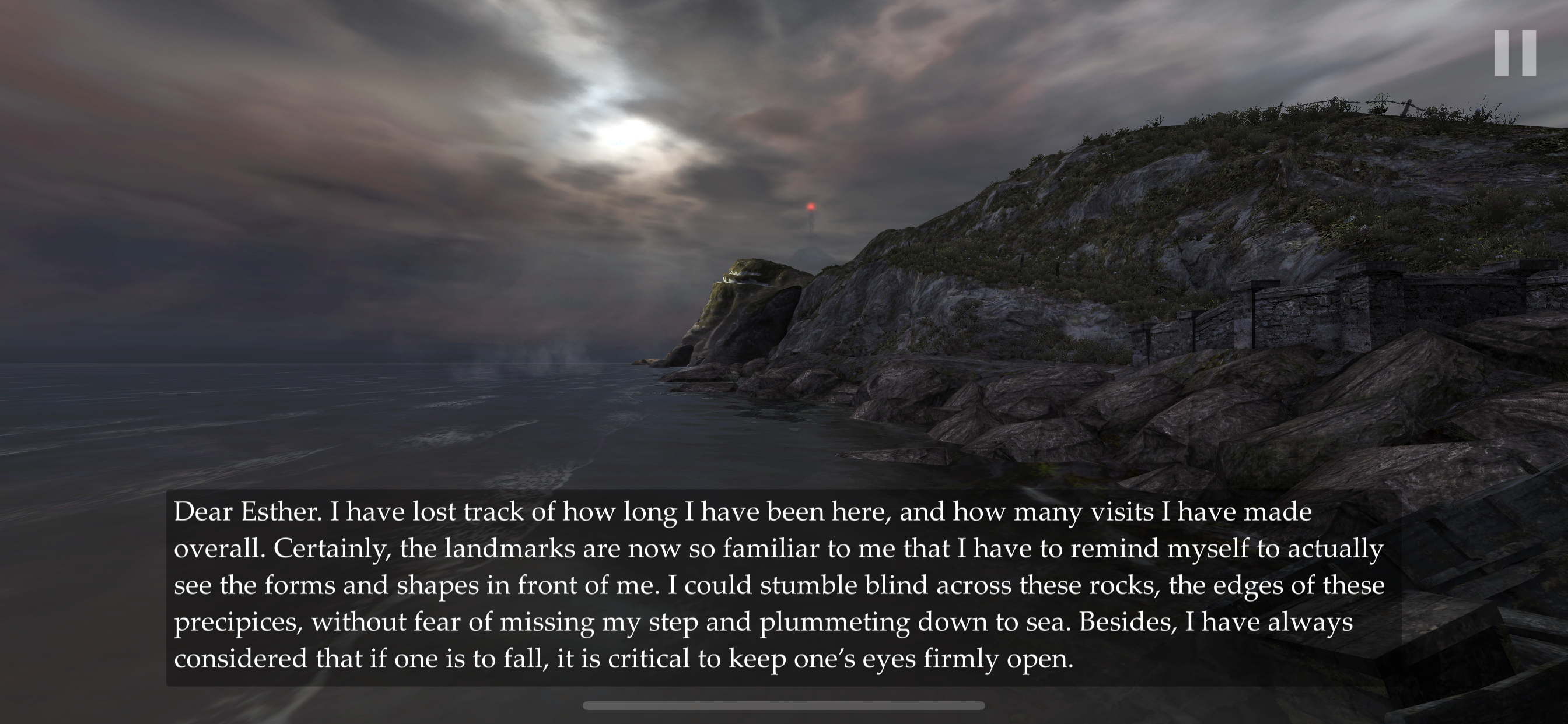Dear Esther is a single-player walking simulator created by The Chinese Room, first released on February 14, 2012 on Windows and May 15, 2012 on OS X, then in subsequent years PlayStation 4 (2016), Xbox One (2016), and iOS (2019, which is where I accessed the game). With minimalistic game mechanics, the player wanders a well-rendered desolate, island with crumbling buildings and the eerie sounds of a roaring wind and the crash of waves. As the player moves — that is the only mechanic allowed — a male voice reads aloud letters addressed to his deceased wife, revealing more about the mystery of the island. (Note: at the time of writing this critical play, I am still finishing the game.)
With the prosaic language contrasting with the purposely barren landscape and sounds meant to evoke mourning and melancholy, this game seems targeted towards an older population who have read or experienced losing a loved one, and aided by the stripped down mechanics and emphasis on atmosphere, this game is open to people with beginner through expert familiarity with other games.
Formal Elements
- Players: Dear Esther is a single-player game (which can be experienced together with others).
- Objectives: The game shares many aspects with visual and musical poetry, with a structured (if fragmented) narrative that is gradually revealed through the main gameplay, which is the player moving through the island to reveal more letter fragments.
- Outcomes: To “finish” the game is to wander through enough notable places so that they have heard and seen all the letter fragments, but there is no single conclusive explanation of what happened on the island; the player must piece together their understanding themselves.
- Procedures: This is a narrative-heavy game, structured with 4 chapters (on the iOS version) that represent different sections of the narrative and the depth of the narrator’s anger and emotion.
- Rules: Players can only move left, right, forwards, and backwards, and this does not include jumping. They can also change their viewpoint for a full 360* rotation from where they are located. Letter fragments are revealed when a player reaches a significant landmark (like a large pile of rocks), and there is no strict chronological fragment ordering.
- Boundaries: The strictest boundary of this game is the screen, the island that the player can wander, and the limitations of the fragmented narrative, which the player can attempt to piece together but never really know.
Type of Fun and High Points
 This game is an interactive story with Narrative, Discovery, and Sensation fun, as it focuses on creating an immersive narrative experience for the player as they discover new locations on the island, including an underground system of caves with paintings of neurons and chemical compounds. Like a mystery novel, the player finds new hints — a rusting crab trap, old medical equipment — and information revealed through the voiced letters, even though the player appears to be the only person on the island. With the visually impressive setting and the cinematic soundtrack overlaid with the background of natural phenomena (trickling water, murmuring wind), the player experiences the narrative while attuned to the sights and sounds they would see and hear if they were actually on the island.
This game is an interactive story with Narrative, Discovery, and Sensation fun, as it focuses on creating an immersive narrative experience for the player as they discover new locations on the island, including an underground system of caves with paintings of neurons and chemical compounds. Like a mystery novel, the player finds new hints — a rusting crab trap, old medical equipment — and information revealed through the voiced letters, even though the player appears to be the only person on the island. With the visually impressive setting and the cinematic soundtrack overlaid with the background of natural phenomena (trickling water, murmuring wind), the player experiences the narrative while attuned to the sights and sounds they would see and hear if they were actually on the island.
The game excels in its use of atmospheric tension and spatial exploration, paring away complicated mechanics and rules to encourage the player to experience the story and the journey of discovery in a contemplative state. Though the mechanics on platforms such as iOS may take some adjustment (I accidentally kept my finger on the left on the screen, and ended up drowning in the water), overall this landmark game has introduced a new form of experiencing — or stitching together — a narrative from story elements.



